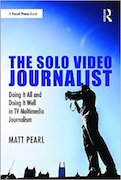March 13th, 2020 was our baby girl’s due date. We didn’t realize how fortunate we were when she arrived two weeks early, two weeks before the coronavirus pandemic fully overtook most Americans’ lives.
By the time March 13th arrived, the NCAA had cancelled the Final Four, the NBA, NHL, and MLB had postponed or suspended their seasons, and the stock market had plummeted. A day earlier, my state of Georgia announced the first death related to COVID-19. That afternoon the United States officially entered a national state of emergency.
This was clearly, also, a journalistic emergency – the kind where anyone who can pick up a camera or write a script is expected to report. I didn’t. On March 13th, I fed and swaddled my newborn, then picked up my older daughter from day care with the knowledge she likely wouldn’t return anytime soon.
I wanted to work. But I wouldn’t cut short this critical period to do so.
A storyteller’s instinct is to rush to the biggest stories. We romanticize it. I’ve heard reporters boast about cutting short weekends, vacations, and honeymoons to cover the latest breaking story. To some degree – and depending on where you work – that’s part of the job. I’ve spent snowstorms on windy, whitecapped bridges. I’ve missed friends’ weddings to cover the World Series and Olympics. I struggle with these sacrifices, but I understand why they’re necessary, and I hope my friends and family do too.
But I wouldn’t sacrifice this. Months before my daughter arrived, I informed my bosses I planned to take four weeks off: two for paternity leave, and two as paid time off. I resolved as many commitments as I could beforehand, and I cleared those weeks to focus solely on family. No story, I pledged to myself, would reel me back.
Then a worldwide pandemic struck American cities, and I felt torn.
I wanted to jump to action. But I wanted more to be with family. I wanted to take my two-year-old for rides on her balance bike. I wanted to bottle-feed my newborn and feel her fuzzy forehead nuzzle against my neck. Mostly I wanted to shoulder my half of the sleep-deprived parental responsibilities and not overburden my wife, still recovering from childbirth and expecting a more gradual return to normalcy.
So I stayed put. I didn’t speed-dial the assignment desk. I didn’t immerse myself in coronavirus news. And my managers – all of whom gave similar “We’re very glad to have you back” speeches upon my return – respected my space and in no way pressured me to shorten my leave. But I felt it regardless, mostly from myself. Whenever I dipped my toe into coverage or discussed the pandemic with family and friends, I was reminded of the singularity of its magnitude. The phrase, “Never seen anything like this,” crossed my feeds and hit my ears daily. Fellow journalists named it the biggest story of their careers. Surely it would be the biggest of mine too, if I wasn’t on the sidelines.
As the days passed, I thought back to Buffalo. In the winter of 2009, my old station’s parent company mandated week-long furloughs. I spent my week in New Orleans, and three days before my return, a Colgan Air passenger flight crashed into a house in a Buffalo suburb and killed 50 people, including everyone on board. It was a tragedy, easily the largest the region had seen in years, and every media member in the market went to work. I couldn’t. Per furlough rules, I couldn’t even check my e-mail.
Then, like now, I felt I had abdicated my duty as a journalist. But when I returned to work a few days later, I realized the value of providing relief and fresh perspective. I wasn’t able to cover the crash itself, but I worked 70 hours over the next six days and brought stories to our viewers of the passengers who lost their lives. I even covered a funeral. I experienced a week of emotional drain, but I knew I had lifted a little from my already overworked coworkers.
With COVID-19, I recognized this early. By the time I began planning my return, nearly all of my colleagues had transitioned to working from home. I reached out to several and learned the strain they already felt. I knew I could inject fresh energy into our now-remote newsroom.
I also knew this story wasn’t going anywhere.
The COVID-19 pandemic will dominate our coverage for months and likely years. These days, I wake up early, feed my newborn, have Pajama Playtime with my toddler, then hop onto Zoom for the morning editorial meeting. I conduct interviews while I calm my one-month-old. I bond with my family and produce stories of substance. It’s absolutely not easy, but none of us have it easy right now. I try to remain joyful and grateful.
And I don’t regret resisting the first few weeks of perhaps my career’s most important story to make sure I savored one of my life’s most meaningful moments.
The Solo Video Journalist is available for purchase. You can find it on Amazon, Barnes & Noble, and the publisher’s web site.
Matt Pearl is the author of the Telling the Story blog and podcast. Feel free to comment below or e-mail Matt at matt@tellingthestoryblog.com. You can also follow Matt on Facebook and Twitter.

